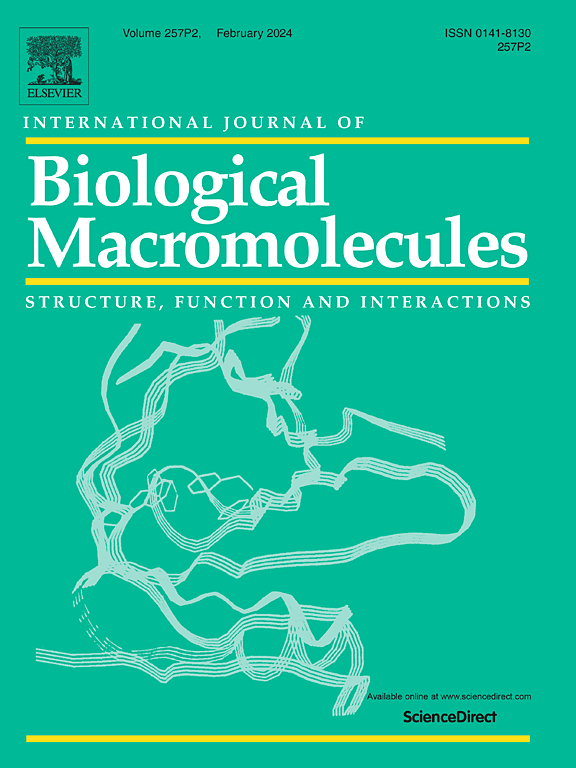开发并鉴定含有功能化聚丙烯腈-苯乙烯/碳纳米管的海藻酸钠珠,以有效吸附水溶液中的铁(II)离子。
IF 8.5
1区 化学
Q1 BIOCHEMISTRY & MOLECULAR BIOLOGY
International Journal of Biological Macromolecules
Pub Date : 2024-12-01
DOI:10.1016/j.ijbiomac.2024.137947
引用次数: 0
摘要
本研究详细介绍了海藻酸钠-聚(丙烯腈-苯乙烯)/碳纳米管(SA-M*Poly(AN-co-ST)/CNTs)复合微珠作为高效吸附剂去除水溶液中铁(II)离子的开发和评估情况。这种复合材料是通过对聚(丙烯腈-共苯乙烯)共聚物进行羧酸基团改性和官能化而制备的,然后将碳纳米管(CNTs)和海藻酸钠整合在一起,形成坚固的凝胶珠。利用扫描电镜、傅立叶变换红外光谱和 BET 表面分析光谱对复合微珠进行了表征,结果显示其比表面积为 127.907 m2/g,孔径为 18.9 Å,表明其吸附潜力得到了增强。批量吸附实验表明,在 pH 值=3.0、接触时间为 80 分钟、吸附剂用量为 40 毫克的最佳条件下,铁(II)的最大去除率达到 90%,平衡吸附容量为 85 毫克/克。动力学研究表明,化学吸附是主要机制,遵循伪二阶模型,而等温线分析则符合 Freundlich 模型,表明存在多层吸附。此外,该复合材料还表现出值得称道的可重复使用性,经过五个再生周期后,其吸附能力仍能保持 80%。这些发现凸显了该复合材料在水处理领域的实际应用潜力,为重金属修复提供了一种可持续的有效解决方案。本文章由计算机程序翻译,如有差异,请以英文原文为准。
Development and characterization of sodium alginate beads incorporating functionalized poly(acrylonitrile-co-styrene)/ carbon nanotubes for effective Fe(II) ion adsorption from aqueous solutions
This study details the development and evaluation of sodium alginate-Poly(acrylonitrile-co-styrene)/ Carbon Nanotubes (SA-M*Poly(AN-co-ST)/CNTs) composite beads serve as a highly effective adsorbent for the removal of Fe(II) ions from water solutions. The composite was prepared through the modification and functionalization of poly(acrylonitrile-co-styrene) copolymer with carboxylic acid groups, Subsequently, carbon nanotubes (CNTs) and sodium alginate were integrated to create sturdy gel beads. The composite beads were characterized using SEM, FTIR, and BET surface analysis spectroscopy, revealing a specific surface area of 127.907 m2/g and a pore size of 18.9 Å, indicative of its enhanced adsorption potential. Batch adsorption experiments showed that under optimal conditions pH = 3.0, 80 min of contact time, and an adsorbent dosage of 40 mg, the maximum Fe(II) removal efficiency reached 90 %, with an equilibrium adsorption capacity of 85 mg/g. Kinetic studies showed chemisorption as the main mechanism, following a pseudo-second-order model, while isotherm analysis aligned with the Freundlich model, indicating multilayer adsorption. Furthermore, the composite exhibited commendable reusability, maintaining 80 % of its adsorption capacity after five regeneration cycles. These findings underscore the composite's potential for practical applications in water treatment, offering a sustainable and effective solution for heavy metal remediation.
求助全文
通过发布文献求助,成功后即可免费获取论文全文。
去求助
来源期刊
CiteScore
13.70
自引率
9.80%
发文量
2728
审稿时长
64 days
期刊介绍:
The International Journal of Biological Macromolecules is a well-established international journal dedicated to research on the chemical and biological aspects of natural macromolecules. Focusing on proteins, macromolecular carbohydrates, glycoproteins, proteoglycans, lignins, biological poly-acids, and nucleic acids, the journal presents the latest findings in molecular structure, properties, biological activities, interactions, modifications, and functional properties. Papers must offer new and novel insights, encompassing related model systems, structural conformational studies, theoretical developments, and analytical techniques. Each paper is required to primarily focus on at least one named biological macromolecule, reflected in the title, abstract, and text.

 求助内容:
求助内容: 应助结果提醒方式:
应助结果提醒方式:


